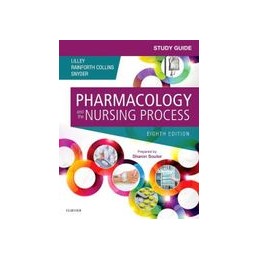- Obniżka


 Dostawa
Dostawa
Wybierz Paczkomat Inpost, Orlen Paczkę, DHL, DPD, Pocztę, email (dla ebooków). Kliknij po więcej
 Płatność
Płatność
Zapłać szybkim przelewem, kartą płatniczą lub za pobraniem. Kliknij po więcej szczegółów
 Zwroty
Zwroty
Jeżeli jesteś konsumentem możesz zwrócić towar w ciągu 14 dni*. Kliknij po więcej szczegółów
Prepare for success in pharmacology and on the NCLEX Examination with the Study Guide for Pharmacology and the Nursing Process, 8th Edition. Designed to accompany Lilleys Pharmacology and the Nursing Process, 8th Edition textbook, this workbook features worksheets for each chapter that include NCLEX-RN® Examination-style review questions, critical thinking and application questions, case studies, and other educationally sound learning activities.
Opis
PART 1: PHARMACOLOGY BASICS Learning Strategies: Introduction to Student Learning Strategies for Pharmacology 1. The Nursing Process and Drug Therapy 2. Pharmacologic Principles 3. Lifespan Considerations 4. Cultural, Legal, and Ethical Considerations 5. Medication Errors: Preventing and Responding 6. Patient Education and Drug Therapy 7. Over-the-Counter Drugs and Herbal and Dietary Supplements 8. Gene Therapy and Pharmacogenomics 9. Photo Atlas of Drug Administration
PART 2: DRUGS AFFECTING THE CENTRAL NERVOUS SYSTEM Learning Strategies: Nursing Process, Assessment, Nursing Diagnoses, and Evaluation 10. Analgesic Drugs 11. General and Local Anesthetics 12. Central Nervous System Depressants and Muscle Relaxants 13. Central Nervous System Stimulants and Related Drugs 14. Antiepileptic Drugs 15. Antiparkinson Drugs 16. Psychotherapeutic Drugs 17. Substance Abuse
PART 3: DRUGS AFFECTING THE AUTONOMIC NERVOUS SYSTEM Learning Strategies: Reading: Vocabulary, Text Notation, and Enhanced Typeface 18. Adrenergic Drugs 19. Adrenergic-Blocking Drugs 20. Cholinergic Drugs 21. Cholinergic-Blocking Drugs
PART 4: DRUGS AFFECTING THE CARDIOVASCULAR AND RENAL SYSTEMS Learning Strategies: Study Time: Learning Styles, The Use of Apps, Mnemonics, Flash Cards 22. Antihypertensive Drugs 23. Antianginal Drugs 24. Heart Failure Drugs 25. Antidysrhythmic Drugs 26. Coagulation Modifier Drugs 27. Antilipemic Drugs 28. Diuretic Drugs 29. Fluids and Electrolytes
PART 5: DRUGS AFFECTING THE ENDOCRINE AND REPRODUCTIVE SYSTEMS Learning Strategies: Making the Most of Group Studying: Study Groups, Chat Rooms, Discussion Groups 30. Pituitary Drugs 31. Thyroid and Antithyroid Drugs 32. Antidiabetic Drugs 33. Adrenal Drugs 34. Womens Health Drugs 35. Mens Health Drugs
PART 6: DRUGS AFFECTING THE RESPIRATORY SYSTEM Learning Strategies: Time Management and Practice Questions 36. Antihistamines, Decongestants, Antitussives, and Expectorants 37. Respiratory Drugs
PART 7: ANTIINFECTIVE AND ANTIINFLAMMATORY DRUGS Learning Strategies: Performance Evaluation and Improvement, NCLEX Practice 38. Antibiotics Part 1 39. Antibiotics Part 2 40. Antiviral Drugs 41. Antitubercular Drugs 42. Antifungal Drugs 43. Antimalarial, Antiprotozoal, and Anthelmintic Drugs 44. Antiinflammatory and Antigout Drugs
PART 8: CHEMOTHERAPEUTIC DRUGS AND BIOLOGIC AND IMMUNE MODIFIERS Learning Strategies: Application of Pharmacology and Making Connections 45. Antineoplastic Drugs Part 1: Cancer Overview and Cell Cycle-Specific Drugs 46. Antineoplastic Drugs Part 2: Cell Cycle-Nonspecific Drugs and Miscellaneous Drugs 47. Biologic Response-Modifying and Antirheumatic Drugs 48. Immunosuppressant Drugs 49. Immunizing Drugs
PART 9: DRUGS AFFECTING THE GASTROINTESTINAL SYSTEM AND NUTRITION Learning Strategies: Active Questioning, Studying for Tests, and Test Taking Strategies 50. Acid-Controlling Drugs 51. Bowel Disorder Drugs 52. Antiemetic and Antinausea Drugs 53. Vitamins and Minerals 54. Anemia Drugs 55. Nutritional Supplements
PART 10: DERMATOLOGIC, OPHTHALMIC, AND OTIC DRUGS Learning Strategies: Future Application 56. Dermatologic Drugs 57. Ophthalmic Drugs 58. Otic Drugs
Appendix: Pharmaceutical Abbreviations Index
